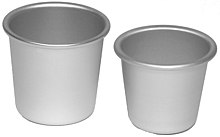
Dessert is a course that concludes a meal. The course consists of sweet foods, such as candy, and possibly a beverage such as dessert wine and liqueur. In some parts of the world there is no tradition of a dessert course to conclude a meal.
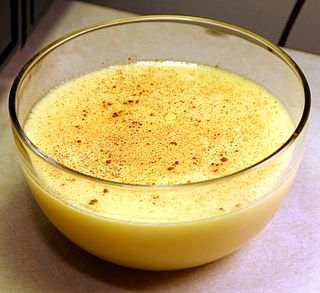
Custard is a variety of culinary preparations based on sweetened milk, cheese, or cream cooked with egg or egg yolk to thicken it, and sometimes also flour, corn starch, or gelatin. Depending on the recipe, custard may vary in consistency from a thin pouring sauce to the thick pastry cream used to fill éclairs. The most common custards are used in custard desserts or dessert sauces and typically include sugar and vanilla; however, savory custards are also found, e.g., in quiche.

Pastry is baked food made with a dough of flour, water and shortening that may be savoury or sweetened. Sweetened pastries are often described as bakers' confectionery. The word "pastries" suggests many kinds of baked products made from ingredients such as flour, sugar, milk, butter, shortening, baking powder, and eggs. Small tarts and other sweet baked products are called pastries as a synecdoche. Common pastry dishes include pies, tarts, quiches, croissants, and pasties.

A pie is a baked dish which is usually made of a pastry dough casing that contains a filling of various sweet or savoury ingredients. Sweet pies may be filled with fruit, nuts, fruit preserves, brown sugar, sweetened vegetables, or with thicker fillings based on eggs and dairy. Savoury pies may be filled with meat, eggs and cheese or a mixture of meat and vegetables.
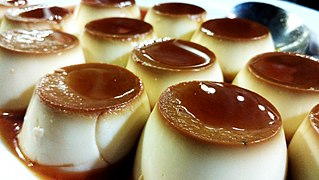
Crème caramel, flan, caramel pudding, condensed milk pudding or caramel custard is a custard dessert with a layer of clear caramel sauce.

A tart is a baked dish consisting of a filling over a pastry base with an open top not covered with pastry. The pastry is usually shortcrust pastry; the filling may be sweet or savoury, though modern tarts are usually fruit-based, sometimes with custard. Tartlet refers to a miniature tart; an example would be egg tarts. The categories of "tart", "flan", "quiche", and "pie" overlap, with no sharp distinctions.

A mille-feuille, also known by the names Napoleon in North America, vanilla slice in the United Kingdom, and custard slice, is a French dessert made of puff pastry layered with pastry cream. Its modern form was influenced by improvements made by Marie-Antoine Carême.

A canelé is a small French pastry flavored with rum and vanilla with a soft and tender custard center and a dark, thick caramelized crust. It takes the shape of a small, striated cylinder up to five centimeters in height with a depression at the top. A specialty of the Bordeaux region of France, today it is widely available in pâtisseries in France and abroad.

Frangipane, is a sweet almond-flavored custard, typical in French pastry, used in a variety of ways, including cakes and such pastries as the Bakewell tart, conversation tart, Jésuite and pithivier. A French spelling from a 1674 cookbook is franchipane, with the earliest modern spelling coming from a 1732 confectioners' dictionary. Originally designated as a custard tart flavored by almonds or pistachios, it came later to designate a filling that could be used in a variety of confections and baked goods.
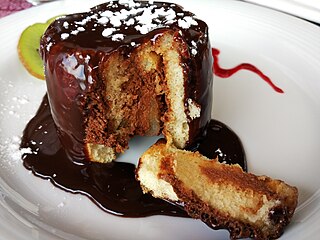
A charlotte is a type of bread pudding that can be served hot or cold. It is also referred to as an "icebox cake". Bread, sponge cake, crumbs or biscuits/cookies are used to line a mold, which is then filled with a fruit puree or custard. The baked pudding could then be sprinkled with powdered sugar and glazed with a salamander, a red-hot iron plate attached to a long handle, though modern recipes would likely use more practical tools to achieve a similar effect.
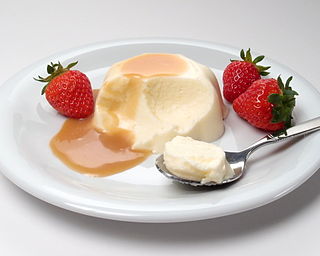
Bavarian cream, crème bavaroise or simply bavarois is a French dessert consisting of an egg-based cooked custard and gelatin or isinglass, into which whipped cream is folded. The mixture sets up in a cold mold and is unmolded for serving. Earlier versions, sometimes called fromage bavarois, did not include eggs or any actual cheese. One recipe using isinglass also calls for crumbled amaretto cookies, chocolate and other flavorings. One contemporary French recipe for "bavarois" is a savory preparation with a neufchâtel-type cheese and leeks, and is not a sweet dessert.

A pithivier is a round, enclosed pie usually made by baking two disks of puff pastry, with a filling stuffed in between. It has the appearance of a hump and is traditionally decorated with spiral lines drawn from the top outwards with the point of a knife, and scalloping on the edge. It is named after the French town of Pithiviers, where the dish is commonly assumed to originate.
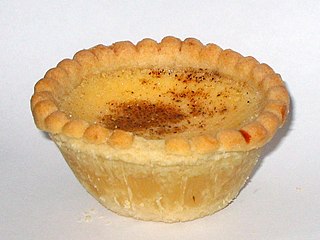
Custard tarts or flan pâtissier/parisien are a baked pastry consisting of an outer pastry crust filled with egg custard.
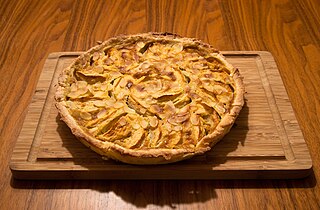
Normandy tart is a shortcrust pastry-based variant of the apple tart made in Normandy filled with apples, sliced almonds and sugar, topped with creamy egg custard and baked until the topping is slightly caramelised. It is also known in French as la Tarte Normande.

A bombe glacée, or simply a bombe in English, is an ice cream dessert frozen in a spherical mould so as to resemble a cannonball, hence the name ice cream bomb. Escoffier gives over sixty recipes for bombes in Le Guide culinaire. The dessert appeared on restaurant menus as early as 1882.

Gâteau Basque is a traditional dessert from the Northern Basque region of France, typically filled with black cherry jam or pastry cream. Gâteau Basque with cream is more typical in the Southern Basque region of Spain.

The pantxineta is a typical dessert of the Basque Country. It consists of a bun of puff-pastry filled with thick custard cream; it is topped with almonds and often decorated with icing sugar.
